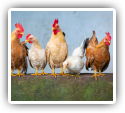Why Did the Chicken Cross the Road? - To Get to the Chiropractor!
Print Article

An unusual study was published by the Annals of Vertebral Subluxation Research on November 21, 2023, showing that chickens that were under chiropractic care were more likely to survive, be larger and taste better when harvested and cooked.
The reason for this study is actually very important. The study begins by pointing out that only 1.3% of the workforce in the United States produces the food for remaining 98.7% of the population. Additionally, they note that the amount of land utilized for farming is decreasing even thought the population, and demand for food, is increasing.
The researchers explain their reasoning by saying, "This research team is exploring the effects of animal chiropractic on livestock overall health, rate of gain, reproductive efficiency, and palatability of meat across multiple species. They will utilize animal chiropractic in production settings to offset challenges the American livestock producer faces while maintaining sustainability of our food supply."
Animal chiropractic and human chiropractic share the same basic premise. Chiropractic is based upon correction of interference to the nerve system created by vertebral subluxations. The researchers further explain, "A subluxation is defined as a shift in the normal structure of one vertebrae in reference to the vertebrae on either side of it. This shift can cause a biomechanical change that can interfere with the nervous system."
This study involved 50 broiler chickens that were obtained shortly after being hatched. The chickens were randomly assigned to either a group that got chiropractic adjustments, or a control group that did not get adjusted. The adjusted chickens all got purple leg bands and the control group got pink leg bands. Both groups of chickens were raised in the same place under the exact same conditions.
All the chickens in both groups were harvested at 65 days of age. All the chickens were then weighed, and the meat from the chickens was frozen. After 88 days, they were thawed, breaded, and fried for a taste test at a local fair. All preparations and cooking for the chickens was the same for all chickens in both groups. Additionally, all participants at the fair did not know which group the chicken they were tasting came from. Only the researchers knew what meat came from which group of chickens.
The results were clearly different between the two groups of chickens. First, the control group of chickens who did not get adjusted suffered an over 12% death rate prior to harvest, while the adjusted group had no deaths among their group. In addition, the adjusted group chickens were heavier on average than the non-adjusted group.
Of the 32 people participating in the blind taste test, 75% preferred the meat from the chickens who had been adjusted. Only 16% preferred the fried chicken from the control group, and 9% did not notice a difference. The participants in the taste test who preferred the chickens that had been adjusted, said that they thought that the chicken was juicer, more tender, and had better flavor.
Print Article


